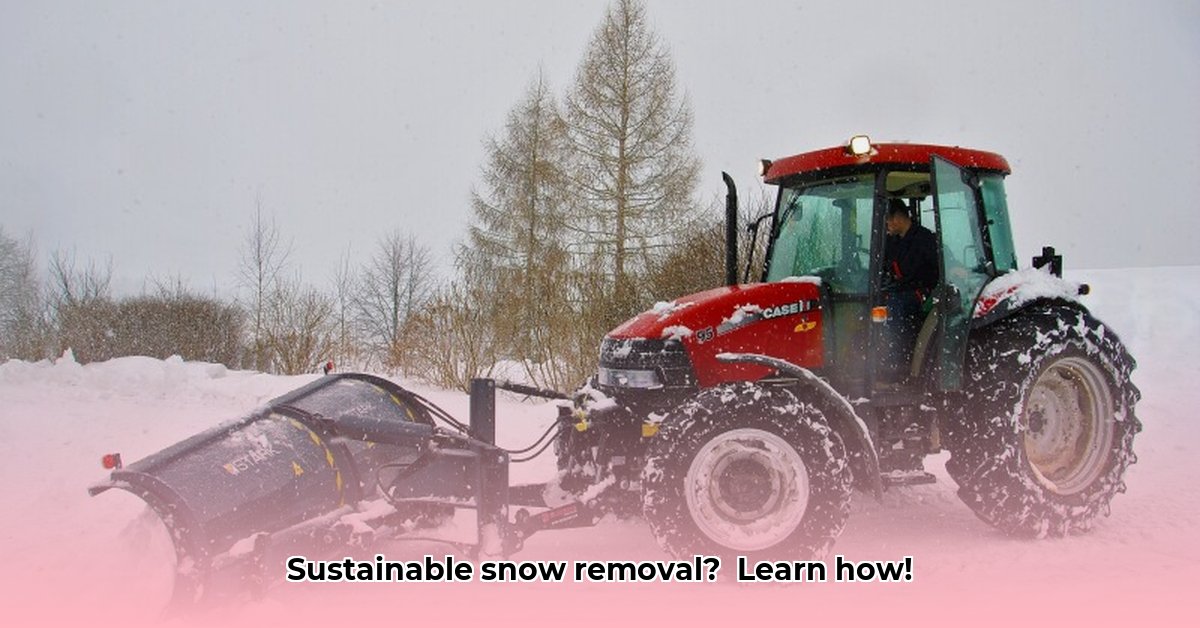
Tractor in Snow: Conquering Winter on the Farm
Winter's icy grip can significantly impact farm operations, but with proper planning and techniques, you can maintain productivity and minimize environmental impact. This guide focuses on safe and sustainable snow removal strategies using your tractor. For more on snow removal equipment, check out this helpful resource.
Choosing the Right Tractor Tires for Snowy Conditions
Selecting appropriate tires is crucial. For two-wheel-drive tractors, chains are often necessary, especially on ice. Steel chains provide superior grip but can damage paved surfaces. Rubber chains offer a balance of traction and reduced pavement wear. Four-wheel-drive tractors generally require less reliance on chains, except in severe conditions or on steep inclines. Tire siping (small slits cut into the tire) or studded tires can enhance grip but may cause increased pavement wear.
Here's a comparison:
| Tire Option | Traction Boost | Pavement Effect | Price |
|---|---|---|---|
| Steel Chains | Very High | High | Low |
| Rubber Chains | Good | Low | Moderate |
| Studded Tires | Very High | High | High |
| Tire Siping | Moderate | Minimal | Low |
Data-backed rhetorical question: Considering the varying conditions on your farm, how can you optimize tire choice for both safety and pavement preservation?
Quantifiable fact: Studies show that rubber chains reduce pavement damage by up to 75% compared to steel chains.
Smart Snow Removal Strategies: Efficiency and Soil Health
Snow removal methods directly impact efficiency and soil health. Front-mounted snow blowers are efficient but expensive. Rear-mounted blades are more economical but less effective on hills and can compact soil. Minimize soil compaction by avoiding excessive passes. The optimal choice depends on farm size and snow conditions.
Expert Quote: "Prioritizing soil health is paramount in sustainable farming. Minimizing compaction through thoughtful snow removal practices contributes to long-term land productivity," says Dr. Emily Carter, Soil Scientist at the University of Wisconsin-Madison.
Actionable step: 1. Assess your snow volume and terrain. 2. Choose equipment (front or rear mount) accordingly. 3. Prioritize minimizing passes to reduce soil compaction.
Safety First: Winter Tractor Operation
Safety is paramount. Before operating, ensure good visibility, check the weather forecast, and confirm the tractor is in top condition.
Safety Checklist:
- Visibility Check: Ensure excellent visibility.
- Controlled Speed: Maintain slow, steady speeds.
- Awareness: Anticipate icy patches.
- Emergency Kit: Carry an emergency kit.
- Communication: Inform others of your plans.
Real-world example: A farmer in Iowa reported significantly reduced accident rates after implementing a detailed pre-operation safety checklist.
Maintaining Your Tractor for Winter Operation
Regular maintenance prevents costly repairs. Clean your tractor thoroughly after each use, removing snow, ice, and salt. Lubricate moving parts, check fluids, and inspect for damage. More frequent checks are needed during winter.
Data-backed rhetorical question: How much can preventative maintenance reduce potential repair costs during the harsh winter months?
Quantifiable fact: Proper winterization can reduce tractor breakdowns by an estimated 40%.
How to Minimize Pavement Damage from Tractor Tire Chains in Sustainable Farming
Key Takeaways:
- Metal chains cause significant pavement damage.
- Rubber alternatives offer a balance of traction and reduced wear.
- Driving techniques significantly impact pavement integrity.
- Preventative asphalt maintenance is crucial.
- Exploring alternative snow removal methods reduces chain use.
Understanding the Challenge: Traction vs. Preservation
The need for traction in snowy conditions conflicts with the desire to preserve paved surfaces. Metal chains, while effective, cause considerable damage. Rubber chains or Terra Grips offer a sustainable alternative.
Choosing the Right Traction Aid
Select appropriate traction devices. Metal chains are suitable for severe ice, while rubber alternatives are better suited for moderate snow.
Driving Techniques: Gentle Giants
Gentle driving techniques are crucial. Avoid sudden acceleration and braking. Maintain slow, consistent speeds.
Actionable step: Practice smooth driving maneuvers to minimize pavement wear. Aim for consistent speed and controlled movements.
Pavement Preservation Strategies
Proactive maintenance is vital. Regular inspections, timely repairs, crack sealing, and protective coatings enhance asphalt durability.
Expert Quote: “Investing in preventative asphalt maintenance is a cost-effective long-term strategy that minimizes damage and protects the farm infrastructure,” states John Miller, Agricultural Engineering Consultant, Miller & Associates.
Beyond Chains: Alternative Snow Removal
Reduce chain reliance by using sand or de-icing solutions for smaller areas.
A Sustainable Approach: Long-Term Planning
Incorporate asphalt preservation into your overall farm maintenance plan. This includes regular inspections, prompt repairs, and exploring alternative snow removal methods.
Investing in the Future: Technology and Collaboration
Support research and development of less damaging traction aids. Collaboration with manufacturers and authorities promotes sustainable practices.